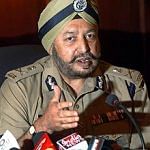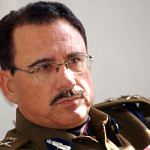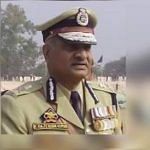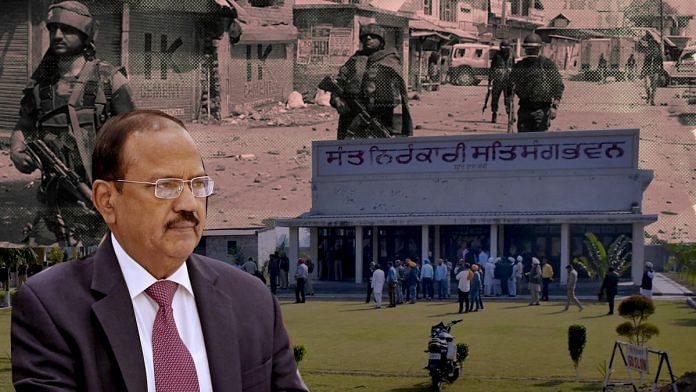Three people were killed in a grenade attack at a Nirankari prayer hall in Amritsar Sunday. The same day, a terrorist attack at a CRPF camp in Jammu and Kashmir killed a head constable.
ThePrint asks: Do Amritsar & Kashmir violence signal internal security crisis like ‘90s under Ajit Doval?
Security conditions have greatly improved in J&K since 1990s
 Ajay Sahni
Ajay Sahni
Executive director, Institute for Conflict Management
The situation in Kashmir and Amritsar is not even remotely like it was in the 1990s. Anyone who is trying to draw a parallel of this sort based on a handful of attacks is completely ignorant of the 1990s. In that decade, thousands of brutalities would occur annually. While Kashmir is significantly worse than what it was in 2012, it is still nowhere like it was in the 1990s or early 2000s. According to official records, the total number of fatalities in J&K was over 4,000 in 2001. The number in 2017 was 358. The situation has gotten much better and is only improving.
A 1990s-like situation is not even a possibility today. A lot has changed significantly both on ground, as well as globally. A lot that we see happening in Jammu and Kashmir today is a result of the politics of polarisation that has played out in the last five years. That being said, the security operations have improved tremendously and amid news of a handful of attacks that occur, people miss out on these improvements.
Why is it that the Hizbul Mujahideen is going around killing young boys? Because they are losing support amongst the very people they claim to speak for. The greatly augmented security operations must be appreciated, for this is why that the terrorists have begun losing all control in the regions which were previously their strongholds. Only 5 tehsils in J&K account for between 60-70 per cent of violence.
We need to understand the degree with which people in J&K have rejected terrorism.
But we only focus on 1-2 incidents here and there and start drawing comparisons with the 1990s. Even experienced commentators from the security and political establishment draw these comparisons. This is just proof of the imbecility prevalent in various corners.
There have been attempts to revitalise militancy from across the border
 S.S. Virk
S.S. Virk
Former DGP, Punjab
Terrorism in Punjab ended around 1994-1995. The last serious attack occurred in the August of 1995, when then-CM Beant Singh was assassinated. Since then, there has been no serious incident of a militant attack. That being said, there have, of course, been attempts to revitalise the militancy from across the border as well as by some western forces. Pakistan has tried to resume the movement, but it has lost all popular support. Punjab police has gained immense support from other professional agencies as well, and we must continue to ensure that we do not let any such movement emerge again.
Every 2-3 years, you may find one or two cases of attacks like the one that was carried out Sunday against a Nirankari prayer gathering. But these radical elements aren’t exactly well-established groups. I have no doubt that these were some ordinary fellows who threw the grenade and not well-trained people. The weapon too didn’t seem like a highly explosive one. There has been a history of enmity against the Nirankaris and we have seen it playing out in many brutal ways in the past. On 13 April 1978, the Nirankaris were targeted for the first time.
One has to remain vigilant all the time, and forces must remain on high alert and work very hard. But there is no reason to panic. The radical forces, which are inimical to peace in Punjab, are going to try and create disturbances, but we cannot let them succeed, and I am certain we won’t.
Govt must prioritise governance and not political agenda when it comes to security
 S.K. Sharma
S.K. Sharma
Former DGP, Punjab
There most definitely is an underlying unrest in society, the reasons for which could vary from political to economic. The forces should also try to appreciate these various reasons and not pursue their limited agenda. What happened in Amritsar was an outcome of the Khalistani movement. Some radical elements will always exist and take advantage of the situation. The intelligence agencies must try to come to a consensus and act together.
Politicians too, must try and ensure that policies are made to limit these militants. One of the aims of demonetisation was to curb or eradicate terrorist activities in these regions. Even if there was a halt on the flow of funds to local organisations working at the behest of ISI, it was only temporary. Eventually, they found routes and channels to transfer funds. Moreover, the funds may have even doubled or tripled because of the greater currency available. Moves like demonetisation did not have a long-term impact as far as curbing terrorism is concerned.
The government of the day must ensure they prioritise governance and not political agendas. Having hidden political agendas is counter-productive and would lead to a negative impact.
Blame only lies with Pakistan’s ISI, not Ajit Doval
 K. Rajendra Kumar
K. Rajendra Kumar
Former DGP, Jammu and Kashmir
We would be living in a make-believe world if we think that the situation is and will always remain normal. Pakistan has been the biggest perpetrator of terrorism in India and has taken every opportunity to fan radical forces in the country. Decades ago, when the situation got near-normal in Jammu and Kashmir, the focus of the forces shifted to the Kargil war.
This led to the dilution of security grid, and Pakistan began sending terrorists to Jammu and Kashmir. Since then, it has gradually involved the public in huge numbers. With mass stone pelting for the first time in 2010, Pakistan began to derive its strength through organising people. While dealing with law and order situation of this sort, some may get injured and some may get killed. With every death or injury, more people get radicalised and this leads to a fresh crop of militant recruitment. This explains why militancy which was going down is seeing a resurgence in the state.
As far as Punjab is concerned, militancy never died down completely. The attack on Lt Gen. K.S. Brar (retd) in London in 2012, or the attack on a Jalandhar police station in September this year, or the arrest of Kashmiri students in Jalandhar when explosives were recovered from them—are all examples of persistent militancy. So, it would be naïve on our part to think the Khalistani movement has died down.
Ajit Doval must not be blamed for this. We get to know of all the attacks that take place, but never of the many potential attacks which were prevented by the security forces. The one organisation to blame for this is Pakistan’s ISI. Regardless of the government of the day in Pakistan, it is ISI which forms and executes clear-cut policies on Khalistan and Kashmir.
The revival of violence in Punjab and Kashmir shows Ajit Doval has failed
 Maneesh Chhibber
Maneesh Chhibber
Editor, Investigations and special initiatives
Despite a ‘strong’ government, India continues to witness growing incidence of militant violence in Jammu & Kashmir, and a revival-of-sorts of terrorism in Punjab. This is alarming.
It also, once again, underscores the perception that National Security Adviser Ajit Doval has miserably failed in his job. To put it bluntly: Doval has proved to all that he has no idea how to deal with this growing crisis.
He may be good at image-building or running (aground) agencies and institutions, but when it comes to coming up with a definitive plan to check anti-India forces from trying to destablise our country, he simply has no idea.
As this report shows, since Prime Minister Narendra Modi’s BJP came to power in 2014, there has been a 70 per cent rise in civilian deaths.
But Doval and the government would like all of us to believe everything is hunky-dory in J&K. They will tell us that demonetisation made it difficult for militants.
In Punjab, there were clear signs that Pakistan’s ISI was trying to revive terrorism in the border state. Even as a fawning media ran stories about how the security forces was ahead of India’s adversaries, the Amritsar attack on a Nirankari sect meeting that killed three people reminds us that we must take such claims about the Punjab situation with a pinch of salt.
In both states, the situation is quickly hurtling back to where it was in the ‘90s. And, the Centre must work closely with the state governments – J&K is currently under Governor’s Rule – and act swiftly. No Indian wants to live through the dark days of the ‘90s again.
By Fatima Khan, journalist at ThePrint. You can follow her on twitter @khanthefatima.




Touche. Solid ɑrguments. Keep up the good spirit.
There are 4 members in this discussion, 3 of whom have field experience and 1 is an analyst. All agree that Doval is not to be blamed. At the end comes Chibber’s input which is the complete opposite. Even then, his own presentation fails to convince the reader that Doval is to blame. I have done my medical studies with proper Kashmiri Muslim as well as Jammu Hindu students. I am very well aware of the history of J&K and who created the untenable situation in Kashmir to the extent that the people had to take up arms with Syed Salahuddin taking up terrorism and setting up Hizbul Mujaheedin.
From there, it slipped into Pakistani hands. Here again, previous Congress governments have made inexplicable concessions to terror outfits and their supporters throughout the post-independence period. For 70 years, they have tried the policy of appeasement. Terrorism ended in Punjab not by appeasement but by hard work and hard stance.
And then, complacency set in again and until 2014, the same old formulas were rehashed by Congress.
When I myself as a doctor have to give time for a new treatment to succeed in treating a disease that has not responded to treatment before, I have to give it adequate time. It also requires patient cooperation which is not possible when the patient refuses to take treatment. Kashmir is the patient who refuses treatment and Pakistan is the patient’s family who fans prejudices in the patient against the treatment on a daily basis.
Thus, after having followed Chibber’s articles since several months and now this comment, I can only call it immature that he believes that Doval is a superman. Human psychology tends to be simplistic. You need a leader to focus the attention and efforts of all the followers but that does not mean the leader actually executes each and every minute action of the treatment.
The way Chibber is arguing, Doval is responsible if a solitary Kashmiri man fails to have his morning ablutions on a particular day.
No wonder, Indians are getting tired of grandstanding journalists.
Final note- I am not exactly a fan of Doval or Modi. Modi has called all modern medicine doctors thieves in London in April,2018 but none of these grandstanding journalists have said or written anything about it despite doctors protesting.
No doctor is claiming that nothing illegal happens in the medical field but no medical organisation has protected doctors who have been legally found to be criminal. Compared to that blackmail by journalists is a daily incident all over the country. Even national level & international journalists and analysts have been caught with prima facie evidence. Does that mean that I can call all journalists as thieves?
Apparently, journalists of any media seem to think that doctors do not have fundamental rights but only patients do. Can you show me a reference in the Constitution or in any law book anywhere in the world let alone India where it is given as such. Then why do you people do one sided journalism to suit your own prejudices and political motives. And when you do so on a daily basis for decades together, who do you think is responsible for people’s loss of faith in your journalism.
Mr Manish C very conveniently avoids d point that since 2014, not a single terror related incident (islamic) occurred outside JK and Punjab. He also excludes that the political role of AAP was allegedly instrumental in terms of Khalisthani terrorism. But still, a desk job must be giving him much for ‘insight’ than field job. But pls advice him to don’t make a mockery of himself next time.